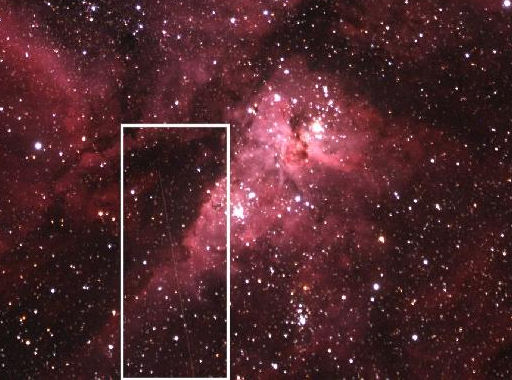M-CLASS SOLAR FLARE: New sunspot AR1675 has just unleashed the most intense flare of the year so far, an M1.9-class explosion at 1550 UT on Feb. 17th. Stay tuned for details. Solar flare alerts: text, voice.
RUSSIAN METEOR STRIKE: On Friday, February 15th at 9:30 am local time in Russia, a small asteroid struck the atmosphere over the city of Chelyabinsk and exploded. According to reports from news organizations and Russian authorities, as many as 1000 people received minor injuries from the shock wave. This is the most energetic recorded meteor strike since the Tunguska impact of 1908.
Researchers have conducted a preliminary analysis of the event. "Here is what we know so far," says Bill Cooke, head of NASA's Meteoroid Environment Office. "The asteroid was about 15 meters in diameter and weighed approximately 7000 metric tons. It struck Earth's atmosphere at 40,000 mph (18 km/s) and broke apart about 12 to 15 miles (20 to 25 km) above Earth's surface. The energy of the resulting explosion was in the vicinity of 300 kilotons of TNT." (continued below)
"A shock wave propagated down and struck the city below, causing large numbers of windows to break, some walls to collapse, and minor damage throughout the city," he continued. "When you hear about injuries, those are undoubtedly due to the effects of the shock wave, not due to fragments striking the ground. There are undoubtedly fragments on the ground, but as of this time we know of no recovered fragments that we can verify."
Videos of the event may be found here and here. In many of the videos you can hear the sound of windows shattering as the meteor's loud shock wave reaches the ground. Onlookers cry out in Russian as alarms and sirens sound in the background. This pair of wide-angle gif animations is also worth watching: #1, #2.
It is natural to wonder if this event has any connection to today's record-setting flyby of asteroid 2012 DA14. Paul Chodas of the Near Earth Object Program at JPL says no. "The Russian fireball is not related to 2012 DA14 in any way. It's an incredible coincidence that we have had these two rare events in one day."
Stay tuned for updates!
Realtime Space Weather Photo Gallery
GOOD-BYE 2012 DA14: Asteroid 2012 DA14 few past Earth on Feb. 15th inside the orbit of many geosynchronous satellites. At closest approach, around 2:25 pm EST, the 45-meter wide space rock was only 17,200 miles above Indonesia. No satellites were damaged by the flyby, and the asteroid is now receding from Earth.
Using a 3" refractor at the Siding Spring Observatory in Australia, Aaron Kingery captured this image of 2012 DA14 passing in front of the eta Carina Nebula:
NASA's Goldstone radar in the Mojave Desert will ping the space rock for the next four days to refine its orbit and map its surface features. Researchers will look carefully for signs that Earth's gravity might have caused seismic activity on the asteroid.

![]()
Solar wind
speed: 361.7 km/sec
density: 1.6 protons/cm3
explanation | more data
Updated: Today at 1627 UT
![]()
X-ray Solar Flares
6-hr max: M1 1550 UT Feb17
24-hr: M1 1550 UT Feb17
explanation | more data
Updated: Today at: 1600 UT
![]()
![]()
![]()
Daily Sun: 17 Feb 13
![]()
![]()
None of these sunspots is actively flaring. Credit: SDO/HMI
![]()
![]()
![]()
Sunspot number: 75
What is the sunspot number?
Updated 17 Feb 2013
Spotless Days
Current Stretch: 0 days
2013 total: 0 days (0%)
2012 total: 0 days (0%)
2011 total: 2 days (<1%)
2010 total: 51 days (14%)
2009 total: 260 days (71%)
Since 2004: 821 days
Typical Solar Min: 486 days
Update 17 Feb 2013
The Radio Sun
10.7 cm flux: 103 sfu
explanation | more data
Updated 17 Feb 2013
![]()
![]()
![]()
Current Auroral Oval:
![]()
Switch to: Europe, USA, New Zealand, Antarctica
Credit: NOAA/POES
![]()
![]()
![]()
Planetary K-index
Now: Kp= 3 quiet
24-hr max: Kp= 3 quiet
explanation | more data
![]()
Interplanetary Mag. Field
Btotal: 6.9 nT
Bz: 6 nT south
explanation | more data
Updated: Today at 1627 UT
![]()
![]()
![]()
Coronal Holes: 17 Feb 13
![]()
![]()
Solar wind flowing from this sinuous coronal hole could reach Earth starting on Feb. 21st. Credit: SDO/AIA. ![]()






